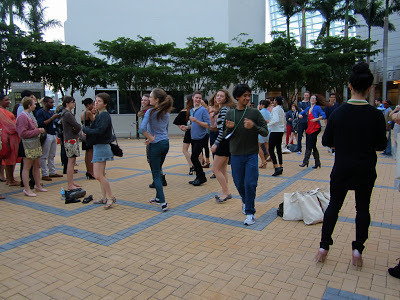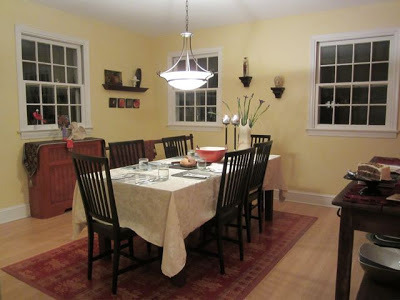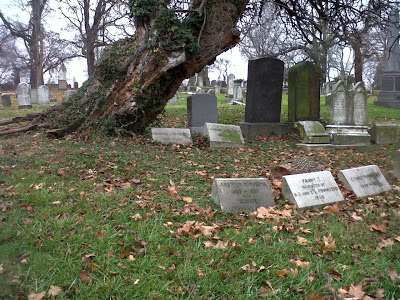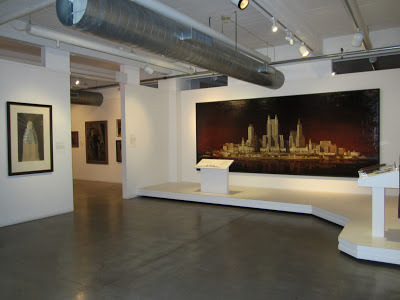Beth Kephart's Blog, page 145
January 29, 2013
be spontaneous

In Miami, during the National YoungArts Foundation program week, teens selected for their talent in nine different disciplines had the opportunity to share their work on major stages. The work itself was extraordinary, of course. But what most deeply touched me was the spontaneous nature of the anticipatory crowds.
Here we are, ahead of the readings by the young writers. The musicians had carried their instruments with them, as they always did, and had broken out into some song. The dancers, hearing the strands of melody, took the music upon themselves—half impulse, half something they might have done before.
I want to live like that.




Published on January 29, 2013 05:11
January 28, 2013
teaching Lucy Grealy's Autobiography of a Face

Each teaching semester at Penn I choose the memoirs I want the class to dwell on, learn from. The Diving Bell and the Butterfly. The Duke of Deception. House of Prayer No. 2. Running in the Family. Slices from Annie Dillard, Patricia Hampl, Vivian Gornick, the memoiristic poetry of Pablo Neruda. More.
This semester we're reading three, and this weekend I was preparing my notes for our coming discussion of Lucy Grealy's Autobiography of a Face, a book with so much to teach that I filled six pages with citations and notes and sent my students more consider-this questions than perhaps a teacher should. As a child, Lucy has cancer. As a teen and young woman she endures more than thirty surgeries—first to remove the tumor from her jaw, then to try to resurrect her face. That's the back story, but it isn't the reason this is such teach-worthy memoir. I will teach Lucy Grealy tomorrow because of her reach—her attempt to make sense, her generosity, her thematic juxtapositions.
Autobiography is full of passages such as this:
By the end of my freshmen year I'd gained a reputation as one of the better poets on campus, which aided the development of my artistic persona. How trivial to actually think about one's appearance. The attire of my fellow scruffy artists told the world to recognize them as geniuses too preoccupied to care about anything as mundane as clothes. But for me, dressing as if I didn't care was an attempt not to care, to show the world I wasn't concerned with what it thought of my face. In my carefully orchestrated shabbiness, I was hoping to beat the world to the finish line by showing that I already knew I was ugly. Still, all the while, I was secretly hoping that in the process some potential lover might accidentally notice I was wearing my private but beautiful heart on my stained and fraying sleeve.
This is my home, my table where I sit with family and friends. Tomorrow I'll take this spirit of community (pretend there are flowers, pretend there are candles), and we'll talk.




Published on January 28, 2013 06:06
January 27, 2013
The Woodlands, my students, and hope: in today's Inquirer

Yesterday I noted that my story about The Woodlands and the students I teach appeared, with my photographs, in this Sunday's Philadelphia Inquirer. The link is now live and can be found here. The story begins like this:
When did we
become what we, on our worst days, seem to be? This nation trampled by
poor compromise and misplaced screech, this drowning swell of
hyper-caffeinated opinion, this landscape of the random and the ruined.
We are increasingly disinclined toward rational debate. We rage about
the inconsequential. We want to be heard, but we don't want to listen.
We're quick to deplore the mess we're in, and tragically ill-equipped to
fix it.
Impotence has never been my thing. I believe in the kids I teach, the
small heroics of neighbors, quantum generosity, anonymous kindness, in
doing something, making something, being something. I believe in the
idea of what lies ahead, what takes us forward. We are. We can.




Published on January 27, 2013 04:18
January 26, 2013
The YoungArts Writers Reading: Victoria White
This is but one of the remarkable twenty-four who read in Miami during YoungArts week. Her name is Victoria White. Listen, and you'll never forget her. Find the others. Listen to them, too.
Our literary future.




Published on January 26, 2013 15:11
Seeking Refuge, Finding Perspective: my Inquirer piece on The Woodlands

The link to the whole story will go live tomorrow (and I will share it then), but after a long and sometimes painful week I am happy to find this story, with my photographs, in this Sunday's Philadelphia Inquirer.




Published on January 26, 2013 06:33
January 25, 2013
Why (some) Teens Don't Read Young Adult Literature

In Miami, as a master writing teacher for the National Young Arts Foundation program, I had the opportunity to spend time with extraordinary young writers—but those of you who read this blog know that. I had asked these very special teens, before we'd met, to tell me about the books that had changed their idea of story, on the one hand, and of language, on the other. When it became clear that few of these teens are spending time with books written for them, I asked more questions and listened intently.
"Why (some) Teens Don't Read Young Adult Literature," my essay now up on The Huffington Post, captures the essence of these conversations. It also showcases a pretty spectacular and diverse reading list—one that sent me out to stores to buy the (few) books I was missing.
You can read the essay here.




Published on January 25, 2013 14:53
January 24, 2013
HANDLING THE TRUTH: a first reading and discussion, at Penn
I am grateful to the famous professor and Kelly Writers House leader Al Filreis for sharing this clip with me yesterday. It brings back a beautiful day, late last October, when I first read from Handling the Truth and joined Cynthia Kaplan, James Martin, and John Prendergast in a conversation about the making of memoir.




Published on January 24, 2013 03:07
January 23, 2013
window frost, student work, and not regretting my age

These are the months when I never sleep. The annual report months, the news magazine months, the teaching months, the cold ache in the bones. I would say that I woke to the frost this morning, but that would imply that I had slept.
Still, beneath two blankets and one burning bulb I read the work of students and was not alone through the dark. I was taking one final look, for example, at Hairography, the book that my husband and I have created on behalf of the YoungArts writers—the students' work in response to a prompt I gave them, their faces and hair as Bill so magically captured both on a windswept day in Miami. It's a beautiful book. How could it not be? And it will be in the hands of these young writers soon.
Later in the night I began to read the first "official" work of my sixteen Penn students. They were writing about a journal I had asked them to keep, reflecting on a Joan Didion essay I'd asked them to read. What is the value of the words you write in the heat of a moment? What will they teach you about now, sometime in the distant when? Who do your words tell you you are, and who do they tell you you can be?
I was reading their thoughts through the dark, closing my eyes to think after each essay was marked. At one point I looked up and the sun was near. A text message revealed that my son had arrived, in plenty of time, for his first (brisk and early) interview of this day.
It's all about the young for me these days. It's why I don't regret my age, perhaps—or don't regret it too severely.




Published on January 23, 2013 05:36
January 22, 2013
Skunked: How to Not Write Bad/Reflections on Ben Yagoda's New Book

Readers of this blog may not be able to guess that I am a lover of books not just about words, but about their placement between marks of punctuation. From where I sit I see (on my shelf) Karen Elizabeth Gordon (Out of the Loud Hound of Darkness, Torn Wings and Faux Pas), Roy Blount Jr. (Alphabet Juice), Roy Peter Clark (The Glamour of Grammar), Patricia T. O'Conner (Woe is I), Kitty Burns Florey (Sister Bernadette's Barking Dog), Peter Bowler (The Superior Person's Book of Words), and all manner of thesaurus and dictionary. I've actually read these books. I have learned from them.
I also own three Ben Yagodas: When You Catch an Adjective Kill it, Memoir: A History, and, as of two weeks ago, How to Not Write Bad. A professor at the University of Delaware, an historian of The New Yorker, a man who can talk knowledgeably about many things (we have shared a place at Elizabeth Mosier's table, we have chatted over Facebook, we have talked about truth and my own long-in-the-making Handling the Truth), Ben is a conversationalist of the first order. He has stories to tell, and he tells them wit-fully.
(There I go, making up words again.)
Ben's new book is an advice book aimed toward those who hope to "not write badly." It was inspired by his students' work, he tells us—by their penchant for using misunderstood words, dangling clauses, spliced commas, homophones, and poorly placed possessives, among other things. Ben has seen bad writing flare. He has returned to tell us about it. He is asking (mostly politely) if we could please do better.
How to Not Write Bad is intentionally full of the basics, in other words. That little reminder to set the right apostrophe in the right place. That hope that we will put "lie" and "lay" to proper use. That gentle corrective regarding I, myself, and me. It is a book that asks us to be mindful, to look back over own shoulders at the language trail we leave, to be our own best copy editors, to read, to look things up.
My favorite parts of the book are those that trace the history of phrases or words. Those parts that decode what was once wrong but is not necessarily wrong now, or could be right tomorrow. It is the transitional nature of language that gets us most confounded, I would suggest. The "certain grammatical constructions [that] are considered okay by some or most authorities but retain an offensive odor for many readers (and, crucially, for teachers and editors), and should be avoided." Ben is well aware of the pitfalls and the trapdoors, and he leads us through his understanding of both in a way that could be helpful when talking with a client, say, about that word "alright," or the streamlining of adjectives, or any other number of things.
Packed with student examples, percolated with Ben's trademark style, easy to read and easy to remember, How Not to Write Bad will now join the other word books on my shelf. I will hope to get more right here in the future—despite my penchant for longish sentences and odd little words, despite my tendency (I'm sorry; there are pressures; I will do better when I can) to blog too fast.




Published on January 22, 2013 06:11
January 21, 2013
spending the afternoon with the world-class artist Michele Oka Doner
At the meal following the YoungArts gala, I had the privilege of being seated near Michele Oka Doner, the renowned sculptor, jewelry maker, fashionista, space maker. Her work can be seen at MOMA, the Louvre, the Cooper-Hewitt, and the FIU-Wolfsonian, where a mural painted by my great uncle Lloyd Morgan, an architectural designer in the firm of Schultze and Weaver, is hung (below). Michele's art can be experienced in retail stores (Tiffany's, say, or Macy's, or Fifty One East, the luxury superstore in Doha, Qatar), in public sculpture gardens, in the Herald Square Subway Station of New York City, and at the Miami International Airport, where she created a nearly mile-long floor of dark terrazzo celestial sea forms in bronze and mother of pearl.
Actually, I'm just scratching the surface here. Michele's work is everywhere.
I'll be joining Michele as one of her new pieces gets cast, and I'll be writing about the experience for the Philadelphia Inquirer.
This is how fate takes us. This is the experience we lean toward.

My great uncle Lloyd Morgan, a visionary architect, painted this imaginary skyline of the many buildings he helped design as a member of the Schulze and Weaver design team—the Pierre, the Waldorf-Astoria, the Sherry-Netherland, the Miami Biltmore, the Breakers—and hung the painting in his Tarrytown, NY, home throughout the years when we visited him as a family. After he passed away, the painting was adopted by my father, who ultimately had it restored and shipped to the FIU-Wolfsonian. I was able to reconnect with the painting for the first time two weeks ago, when I visited the quite beautiful Wolfsonian during my experience at YoungArts.




Published on January 21, 2013 06:14



